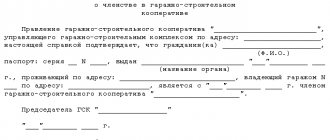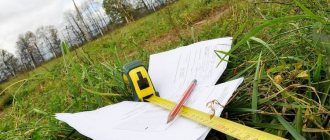From August 4, 2021, the permit to build a house was replaced by a notification. You need to notify government agencies twice: about planned construction and about completed construction. Detailed instructions for actions at all stages were written by a FORUMHOUSE member with the nickname IMHO. Following these instructions, many residents of our portal have registered ownership of their homes.
Those who have received a Construction Permit can skip the first two stages of the quest, but the next three are required for everyone!
Stage one: writing a Notice of planned construction/reconstruction
On paper you should write:
- Full name and passport details and information about the place of registration (registration).
- Cadastral number of the land plot on which construction or reconstruction is planned, information about the owner, type of permitted use.
- Parameters of the future home.
- “Oath promise” that you will not divide the house into apartments.
- Contact address (electronic or postal).
The Notice of Intent must be accompanied by:
- copies of title documents for land (not necessary; they can also request it from Rosreestr);
- if construction/reconstruction is planned in a historical zone, then you need to attach a description of the external appearance of the individual housing construction project or garden house, plus a “graphic description”.
This is all. The notification is submitted on paper directly to the local administration (or through the post office or MFC).
Rights of participants in shared ownership of a land plot
If the documents for home ownership indicate a land plot with a specific area, then in accordance with Article 35 of the Land Code of the Russian Federation, when the ownership of the house is transferred to the new owner, the right of ownership of the land plot is also transferred to him on the same terms and in the same volume as the previous one owner. And vice versa, “all objects firmly connected with land plots follow the fate of the land plots, with the exception of cases established by federal laws” (Clause 5, Part 1, Article 1 of the Land Code of the Russian Federation).
Participants in shared ownership can exercise the right to determine the procedure for using a residential building and land plot, which does not terminate common ownership and does not entail the loss of the preemptive right to purchase shares of co-owners.
The procedure for determining shares in common property is established by Article 245 of the Civil Code of the Russian Federation. If the shares of participants in shared ownership cannot be determined on the basis of law and are not established by agreement of all participants, the shares are considered equal. Consequently, when dividing a land plot, ownership of it is usually proportional to the share of ownership of the home.
Participants in shared ownership may enter into an agreement on the procedure for determining and changing shares in ownership, depending on the contribution of each co-owner to the formation and growth of common property. Thus, a land plot in home ownership does not have to be divided in equal shares between co-owners. Next, we will consider how you can change the share due to one of the owners during division.
Division of land and termination of shared ownership
Termination of common shared ownership of a land plot can occur by dividing it or allocating its share. In case of division of a land plot, the common property for all co-owners is completely terminated. In the case of allocation of a share, one of the co-owners receives private property, while the others retain common shared ownership.
In the absence of an agreement between the co-owners, the decision to divide the land plot and terminate shared ownership is decided in court. Article 24 of the Code of Civil Procedure of the Russian Federation recognizes such disputes as the subject of consideration by district courts as courts of first instance.
According to Article 252 of the Civil Code of the Russian Federation, a participant in shared ownership has the right to demand in court the allocation of his share and the division of common property. The division of a land plot and the allocation of a share of the land plot to one of the owners of common shared property means the loss of his right to this share in the common property. Division of a land plot in court implies that a participant in shared ownership has the right to receive a larger share of the common property if he proves that he has made inseparable improvements to this property. For example, if one of the co-owners, with the permission of the other co-owners and in compliance with the necessary regulations, increased the value of the common shared property during the period of ownership (for example, built new houses and outbuildings on the land plot, repaired or rebuilt the house).
In order to qualify such actions of a co-owner of common shared property as inseparable improvements to the property, they must satisfy specific requirements. Construction, reconstruction, increase or decrease in the usable area of a residential building and any changes to the common property should be carried out only after obtaining the necessary permits and with the consent of all participants in shared ownership.
If one of the participants in shared ownership does not agree with the changes proposed by the other co-owner, the first has the right to go to court. To do this, it is necessary to collect a package of documents: • project of the proposed construction; • permission from the government authority for planned changes; • conclusion on the project’s compliance with the requirements of town planning regulations, construction, environmental, sanitary and hygienic, fire safety and other rules and regulations.
In addition, before starting work, it is necessary to allocate a share in the common property in kind or formalize the division of the land plot through an agreement or through the court.
Stage two: we receive a Notification of compliance/or non-compliance
The notification must be received within seven business days, and by owners of plots in the historical zone - within 20 days.
You can be refused to issue a Notice of Compliance if:
- the parameters of the future home do not meet the maximum parameters;
- houses cannot be built on this plot of land at all;
- The application was not submitted by the owner of the land plot.
IMHO FORUMHOUSE member
There are no other grounds for refusal.
If the applicant does not receive a Notice of Non-Compliance within seven working days, it will automatically be deemed to have been granted the right to build.
The validity period of the Notice of Compliance is 10 years. It is “inherited” by the new owner of the site. Sometimes it happens that during the construction process an irresistible desire arises to change the parameters of the object. In this case, you must submit the Notification again.
Availability of infrastructure near the land plot
- Electrical networks. Connecting a site to electricity is easy and relatively inexpensive. However, the remoteness of the land from communications significantly increases the cost of laying cables. Often, local authorities do not want to spend money on building power lines to detached houses, so the purchase of equipment often falls on the shoulders of land buyers.
- Gas supply. Liquefied gas is more expensive to buy than natural gas supplied from a centralized network. Therefore, it is better to spend money once on laying a gas pipeline than to overpay at exorbitant prices later. The best option is if gas communications are already connected to the site.
- Water pipes. When buying land, developers often forget about water supply. When the facility is ready, it turns out that the water in the broken well does not meet the standards for consumption and domestic use, and it is too expensive to filter it. It is better to inquire in advance with future neighbors about water quality.
- Sewerage. It’s good if it’s central, but if it’s not there, it’s also not a problem. Anyone can afford to build an effective septic tank. Some models of autonomous purifiers provide process water, which is reused for watering beds and garden trees.
- Roads. The ideal option is an asphalt road maintained by the local government. A well-rolled primer is also an option. The best time to look at the quality of driveways is in the spring, when the snow melts. Otherwise, car repairs and constantly dirty shoes will cost you more.
Stage three: send a Notification of Completion of Construction
Notification of completion of construction is submitted no later than one month from the date of its completion.
On paper you must indicate:
- Full name and passport details, place of registration (registration).
- Cadastral number of the land plot on which the house was built or reconstruction was carried out, information about the owner and type of permitted use.
- That the house is not divided into apartments.
- Address of how to contact you (email or postal).
What documents need to be attached to the Notification of Completion of Construction:
- technical plan of an individual housing construction project or garden house (necessarily in paper form and on disk). Any CI will make it for an average of 5,000-10,000 rubles.
- if it is shared ownership, then an agreement on shares. A sample can be found on the Internet.
- a receipt for payment of the state registration fee (350 or 2000 rubles depending on construction or reconstruction).
This notification is also submitted strictly on paper:
- in person to the local administration;
- or through the post office;
- or through the MFC.
The administration must respond no later than seven days.
The land and the house on it will be one piece of real estate
Origins of the issue
In Soviet times, land belonged to the state. However, in 1990, the right to private property was introduced, which extended to houses and then to plots. So we ended up with two real estate properties, which sometimes creates considerable difficulties. For example, when registering and inheriting a house with a plot of land. Changes to the Civil Code (Civil Code) will be adopted, then everything can be done immediately. The land and all buildings that are erected on it will be considered one piece of real estate with a common cadastral number. This is a common practice in Western countries.
Pavel Krasheninnikov, Chairman of the State Duma Committee on State Construction and Legislation, announced the upcoming amendments. The bill was adopted in the first reading and divided into parts for elaboration.
Mass re-registration?
That is, we will have to go and re-register houses with plots - according to the new procedure? The official believes that this will not be necessary.
Pavel Krasheninnikov, Chairman of the State Duma Committee on State Construction and Legislation
“In order to avoid obvious problems in the areas of state registration and taxation, the transitional provisions of the bill provide for a rule according to which the previous cadastral registration and taxation procedure is maintained for buildings and structures on land plots. It will be indicated that they are an integral part of the land plot. So there will be no mass re-registration or recalculation of tax rates.”
Pavel Krasheninnikov also emphasized the advantages of the innovation. The house and plot will be registered as a single piece of real estate. This means that fewer documents will be required and taxes will be reduced. And, of course, it will save time and nerves.
Pavel Krasheninnikov, Chairman of the State Duma Committee on State Construction and Legislation
“It is expected that the number of bureaucratic procedures will be reduced: citizens will not have to register their land separately or their house separately. Everything can be done in one go.”
Unnecessary complications
However, some lawyers do not see the need for these amendments. Experts are sure that homeowners will face unnecessary troubles. If there is only one house on the site, then there should be no problems. The property is not difficult to sell. But what if several buildings, residential and non-residential, are built on the land, and the owner wants to sell one of the houses? The head of a large law firm is afraid that part of the land will have to be allocated to be transferred to the buyer - what part is this, how to determine the boundaries. There are many questions. This problem already exists, and the coming changes, according to lawyers, may well aggravate it.
There will likely be new opportunities for scammers. Unscrupulous cadastral engineers may call a vulnerable elderly person and insist on a speedy re-registration - “according to the new order”.
Summer residents will win
The managing partner of another law firm spoke about the advantages of amendments to the Civil Code for gardeners. In his opinion, summer residents are forced to register all residential and outbuildings on their property, and this, despite the country amnesty, is quite troublesome. We need documents, plans, descriptions. Otherwise, they will face unpleasant consequences associated with tax evasion.
The State Real Estate Inspectorate is actively engaged in identifying unauthorized buildings - with the help of drones. Over the past year, more than 900 unauthorized constructions were discovered in Moscow this way. And if the land plot and everything on it becomes a single object, then registration will be within one action. Moreover, gardeners will be able to save on state fees (for registering the transfer of rights or for initial registration).
The case of inheritance - the plot is yours, and the house is mine
Until the amendments to the Civil Code are adopted, unpleasant situations arise. One of the popular online publications told the story of a family with three adult children. After the death of the mistress of the house in a rural area, their mother, the heirs were unable to peacefully resolve the issue of who would get the property. In her will, the woman bequeathed a garage and ½ of a house to her eldest daughter, and ¼ of this house to her second daughter and son. But nothing was said about the site. It was not possible to reach an agreement, because all the children of the deceased also laid claim to the land.
A long trial began, the decisions were protested - first by one heir, then by another. It reached the Supreme Court (SC). According to the current law (Article 130 of the Civil Code of the Russian Federation), the site and buildings on it are “independent” objects. Therefore, the Civil Division of the Supreme Court ruled that different objects can be disposed of separately. The judges considered that the site is not considered an appendage of a building, but the owner of a house or other structure can use the land. And you can bequeath a plot separately from the house. Although Article 1 of the Land Code talks about the principle of the unity of fate of the land and the objects that are located on it.
The Supreme Court emphasized that since the owners of the house and the plot are the same, the principle is not violated. The discrepancy between the shares does not matter. And all decisions made on this inheritance dispute were canceled, and the case was sent to the first instance - for a new consideration, taking into account the clarifications of the Supreme Court.
If the amendments, as Krasheninnikov promises, are adopted in the near future, a number of similar issues will be resolved faster.
When to submit a Notice of Completion
This point worries many developers who are in a hurry to legalize their property.
id280871FORUMHOUSE member
I'm practically having an existential crisis here. When is a house considered built? When they put it under the roof and fitted the doors, or when there is a floor and a ceiling and there is no scaffolding inside, and the lights are on and water flows from the tap?
The notification can be submitted at the stage that suits the cadastral engineer. Practice has shown that the best moment for this is when the frame, windows, doors and roof have already been built. Interior walls are needed to calculate the area of each room. The cadastral engineer must submit a copy of the Notice of Commencement of Construction along with a planning organization diagram of the land plot (SPOZU).
Stage five: sending documents to Rosreestr for cadastral registration and registration of rights.
The documents must be sent by City Hall employees no later than seven days after receiving the Notification of Completion of Construction, but if they hesitate, and this happens quite often, you can take the papers to the MFC yourself.
Good news for self-builders: a bill on extending and expanding the “dacha amnesty” has already been sent to the State Duma, and soon it will be possible to register a house as a property using a simplified scheme.
All approved notification forms are contained in Order of the Ministry of Construction of the Russian Federation dated September 19, 2021 N 591/pr “On approval of notification forms required for the construction or reconstruction of an individual housing construction project or garden house.” They can be downloaded and filled out.
What should the duty be according to law?
At the MFC you may be required to pay a fee of 2,000 rubles. In this case, it is good to have a printout from the Tax Code with you:
Section 333.33. The amount of state duty for state registration, as well as for performing other legally significant actions.
1. State duty is paid in the following amounts:
22) for state registration of rights, restrictions (encumbrances) of rights to real estate, contracts for the alienation of real estate, with the exception of legally significant actions provided for in subparagraphs 21, 22.1, 23 - 26, 28 - 31, 61 and 80.1 of this paragraph: for individuals persons – 2,000 rubles;
24) for state registration of an individual’s ownership of a land plot intended for personal subsidiary farming, dacha farming, vegetable gardening, horticulture, individual garage or individual housing construction, or for a real estate object being created or created on such a land plot - 350 rubles.
Thus, only the amount of duty for reconstruction or transaction is 2,000 rubles. Armed with this important knowledge, many FORUMHOUSE users have been able to save big.
Here is the story of a portal participant with the nickname Sergei 134. He handed over the entire package of documents and a receipt for payment of the state fee in the amount of 350 rubles. Soon he received a call from the local administration, informing him that the package of documents was at the MFC, and he only had to pay an additional fee of 2,000 rubles. Sergey printed out the above excerpt from the Tax Code of the Russian Federation and showed it to the MFC employee.
Sergey 134
Member FORUMHOUSE
She started mumbling something about how everyone here pays 2,000 rubles for registration, and I’m so smart, I paid 350 rubles in total. And she also said: if you register, you will be the first to pay only 350 rubles, but most likely there will be a suspension.
After some time, Sergei’s new house appeared on the Rosreestr website with a cadastral number, area, information about the owner and cadastral value. He went and picked up a package of documents from the administration (here we omit the story about how documents were lost at the MFC and the administration and were found thanks to the magic phrase “let the prosecutor’s office now look for my documents”).
Sergey 134
In conclusion, I would like to say a huge thank you to this forum and a special thank you to all those participants who gave sensible answers to my questions.
Sergei told his friend who had to register the house about his victory over the system and gave him the same printout. At first, the MFC also demanded 2,000 rubles, then “they read it, whispered and took a receipt for 350 rubles.”
Yulia8kvartal Member of FORUMHOUSE
We also paid 350 rubles for registering the house and re-registering the land as our property. No one demanded 2 thousand, apparently, in your city this is intended for a fool, and you are the first smart one who caught them.
Choosing a house wisely
Choosing a country property is not only a choice of a specific house, but also a choice between different formats of such real estate. This could be a house built on a plot for individual housing construction (IHC), in a garden non-profit partnership (SNT) or in a dacha non-profit partnership (DNP). The last option should probably be immediately excluded - it is more intended for a very “easy” country holiday, and even connecting communications to the house will be difficult.
Most often, when choosing a house with a plot, there are more expensive options with individual housing construction and cheaper ones with SNT.
Individual housing construction
- this is the type of permitted use of the site, which is suitable for capital construction. In this case, the site for individual housing construction must necessarily be located within the boundaries of a populated area, SNT or DNP. Individual housing construction has quite a lot of advantages - in a house built on such a plot, you can register your place of residence (registration), the bank will accept such a plot as collateral for a mortgage, it is much easier to connect all the necessary communications to it, and the city administration will build the road. There is only one minus - the price.
Garden non-profit partnership
is a union of several plots intended for agricultural activities. There may be a house on such a plot, but this is not necessary. At the same time, on the territory of SNT you can run a personal household (garden, vegetable garden), you can build a house (even a capital and all-season one), you can connect communications to it. There are also disadvantages - it is difficult to register in such a house, you will have to pay for communications at your own expense, and the owner of the plot is quite dependent on the decisions of the management of the partnership.
Alexander Tsyganov also speaks about the problems of SNT - in his opinion, the issue here is rather about price. If the buyer is ready to sacrifice some advantages for the sake of a low price, he can choose SNT, if not, then individual housing construction:
Buying a house in a regular settlement often involves large utility bills. An ordinary individual housing construction in a village is more convenient than land in a garden partnership (SNT), but it costs more. In SNT, you need to be ready to chip in to build a road, often narrowing it, supplying gas, repairing water pipes, and clearing snow. When choosing a future dacha, you need to look at possible restrictions due to the characteristics of the land. There may be a security zone, gas pipeline, etc. nearby, which will interfere with quiet life and construction. This can be looked at on the cadastral plan or consulted with realtors. You should also evaluate the distance to the fence and the width of the site; building codes are in effect now and it is often impossible to modernize or build something. The next question is communications. It’s good if there is main gas and it is already connected. If not, then you need to evaluate the possibility of connection or alternative heating methods. In SNT, most often the connected electrical power does not exceed 5 kW, which is not enough for heating in cold weather. For urban amenities, it is necessary to equip a well and a sewerage outlet, which also needs to be paid attention to. Relations with neighbors can ruin life in nature, but it is very difficult to assess this in advance. But cases of breeding chickens, goats, rabbits and bees can be seen immediately and the question of the advisability of living next to them can be decided.
Alexander Tsyganov
, Head of the Department of Insurance and Social Economics, Financial University under the Government of Russia.
But as for the question - buy a ready-made house or a plot for construction
, then everything is again not so simple. On the one hand, a plot of land in SNT can be found for more than normal money, and many construction companies offer ready-made sets of houses at affordable prices. However, in reality, it most often turns out that it is more profitable to just buy a ready-made house.
Thus, Alexander Tsyganov says that the only option when buying a building plot will be more profitable is if the buyer himself can be a foreman or he has such friends/relatives. On the other hand, buying a ready-made house is also quite risky
– it is advisable to involve a specialist in the inspection, who will check all the “weak points” in the house. At the same time, the most popular frame houses now are considered more problematic - and they need to be inspected especially carefully.
True, not so long ago a relatively profitable option for construction on credit appeared in Russia - the so-called “wooden mortgage”. Its essence is that when purchasing a house kit from one of the accredited construction companies, you can get a mortgage loan at a reduced rate, and the difference with market conditions will be covered by the state.
But such a mortgage had many disadvantages - a limited list of construction companies
, restrictions
on the loan amount
(3.5 million is not enough for the Moscow region), as well as restrictions on
the type of
houses (inexpensive panel houses were not included). As a result, the program was suspended, but most recently the government announced the possible launch of a new mortgage program for the purchase of wooden houses.
How to register a land plot
If all the documents are in order, then registering a land plot is easy: you just need to write an application for registration of land rights and submit it to Rosreestr or the MFC. Here are the documents you need to attach to your application:
- documents of title to the land plot: agreement (purchase and sale, exchange, donation, rent), certificate of inheritance, a court decision that has entered into legal force;
- cadastral passport of the land plot.
This is an ideal situation. But there are also common ones that are included in the headlines of topics on our portal, like: “I only have a gardener’s book. Is it possible to register the land, build and live with this?” Answer: no, you can't.
DimkalabLawyer, consultant FORUMHOUSE
The membership book is not a document of title; if someone “sells” the land using the membership book, the buyer will not be able to become the owner.
The gardener's membership book only confirms that its owner is a member of SNT. It is not the basis for registering a land plot and not the basis for state registration of ownership of a land plot.
AlexslonForumHouse Member
The neighbors bought the plot in 1996, at that time it was common practice to purchase a “Gardener’s Membership Book,” which gave the appearance of transferring ownership of the land plot. Since then, they have regularly paid all payments in favor of SNT, worked out their work, etc. But all attempts to register the plot stall at the stage of collecting documents. They've been struggling for three years and can't get it processed.
To register ownership of a plot of land, you need a foundation document. You need to get it first, and one of the following documents will do:
- resolution (decision, order) of local authorities on the allocation of a land plot;
- the court's decision.
Dimkalab
If you want to privatize your plot, then you need to find the basis document (resolution on the allocation of land, decision, etc.), which can be ordered from the district archive.
Further, the FORUMHOUSE consultant recommends proceeding according to the following scheme:
- order a cadastral passport of the plot from the Cadastral Chamber;
- if the passport has not been registered in the cadastral register, then register it using the basis document;
- Having received a cadastral passport for the land, register ownership and receive a certificate of ownership.
Tying a building to the ground, what does this mean?
Any structure fundamentally connected to the land, according to the current laws of 2021, must be registered in the cadastral register and registered with Rosreestr.
Registrars accept documents for buildings and structures prepared and signed only by specialists - cadastral engineers. In turn, documents for registering houses (technical plans) must contain information about the location of the building (house, bathhouse, garage, etc.).
In the law, the concept of “House Linking” is referred to as determining the location of a building on a land plot by determining the coordinates of characteristic points of the contour of such a building.
Thus, in order to register a house and put it on the cadastral register, you need to prepare a technical plan, which contains, among other information, the coordinates of the building’s outline.
In order to obtain coordinates, surveyors (in rare cases cadastral engineers themselves) go to the area and make the necessary measurements. Subsequently, information about the coordinates is included in the documentation and reflected on the public cadastral map of Rosreestr.
Let's sum it up
Despite all the assurances, registering a house without a building permit is no easier than with one. You need to go through all the stages of an intricate quest:
- write a notice of planned construction or reconstruction;
- within seven working days, receive a Notice of Compliance or Non-Compliance;
- send a Notice of Completion of Construction. Make sure that the amount of the fee does not exceed that established by law;
- receive a Notification of Compliance of constructed or reconstructed facilities;
- if necessary, encourage the MFC and the administration to transfer documents to Rosreestr for cadastral registration and registration of rights.
It is clear that each situation has its own characteristics, but even taking these characteristics into account, you can always get practical advice from our consultants and experienced users. To do this, we recommend an excellent thread on our forum: Registration of a house on the lands of private household plots, individual housing construction - 2. You can also find out how to receive notification of the planned construction or reconstruction of an individual housing construction project without unnecessary hassle. Get acquainted with legal recommendations for purchasing unfinished property. Find out which dachas, from the point of view of cadastral chamber specialists, are dangerous to buy. Watch our video on how to optimize costs when building a house.
Sale of a share of a plot in common shared ownership
According to Article 37 of the Land Code of the Russian Federation, only land plots that have undergone state cadastral registration can be the object of purchase and sale. Based on Article 250 of the Civil Code of the Russian Federation, participants in common shared ownership have a pre-emptive right to purchase the share being sold when concluding sales and exchange agreements with an outsider. In this case, the selling party has the right to choose which of the co-owners will sell its part of the common shared property.
A plot of land can become private property on the basis of acquisitive prescription. According to Article 234 of the Civil Code of the Russian Federation, a citizen who conscientiously, openly and continuously owns real estate as his own for fifteen years acquires ownership of this property. This rule is applicable to private property and ownerless property and is not applicable to land plots in state and municipal ownership.
If you are thinking about selling a share of a plot that is in common shared ownership or want to exercise other rights related to your ownership of common shared property, consult with a lawyer. Competent protection of the owner's rights when concluding contracts will eliminate many problems when using the property later.
Kizimov Denis Yurievich Lawyer on land issues










